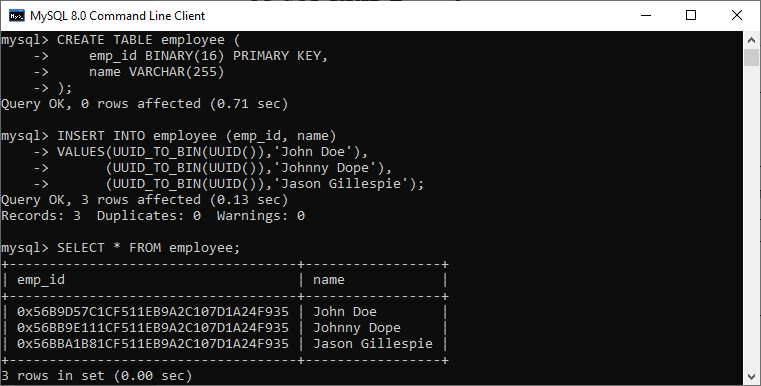

Regular IDs make it easy to get information about the application, like how many users the application has.
#MYSQL UUID PRIMARY KEY DEFAULT UPDATE#
It is a very important step to update our migration file, I want to use the UUIDs in my User class so I will make changes to my User’s migration class. Instead of using auto-incrementing integers as your Eloquent model's primary keys, you may choose to use UUIDs instead. UUIDs are represented as a hexadecimal string split into five groups separated by hyphens.UUIDs are universally unique alphanumeric identifiers that are 36 characters long. In addition, the values of the primary key column will be generated automatically using the uuidgeneratev4() function. Thus the leftmost group varies the fastest (10 times per microsecond).UUIDs stands for Universally Unique Identifiers and are 128 bits values used to uniquely identify some record in our database.

MySQL’s UUID() uses version 1, which implies, as explained in paragraph 4.1.2 of the RFC, that the three leftmost dash-separated groups are a 8-byte timestamp: leftmost group is the low four bytes of the timestamp second group is the middle two bytes, third group is the high (most significant) two bytes of the timestamp.

They exist in several versions, and different sources can generate different versions. To understand that, we need to learn more about UUIDs. Version-5 UUIDs are similar, but SHA-1 is used instead. CREATE TABLE customers ( id BIGINT NOT NULL AUTOINCREMENT PRIMARY KEY.
#MYSQL UUID PRIMARY KEY DEFAULT HOW TO#
However, if we have a choice, as the binary form is shorter, it looks more logical to index it, not the text form – the index will be smaller and thus faster to traverse, faster to backup…įinally, there is the question of how to smartly re-arrange bytes in the binary form. Since 6 or 7 bits are thus predetermined, only 121 or 122 bits contribute to the uniqueness of the UUID. uuid1() function is used to generate a UUID from the host ID. That is a new feature introduced in MySQL 5.7.8.

Even though id_text is a virtual column, it is possible, as above, to add an index on it (in that case, the index does occupy disk space).


 0 kommentar(er)
0 kommentar(er)
